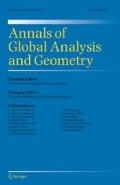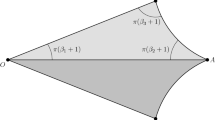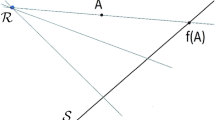Abstract
The goal of this article is to prove that on surfaces with asymptotically cusp ends the relative determinant of pairs of Laplace operators is well defined. We consider a surface with cusps \((M,g)\) and a metric \(h\) on the surface that is a conformal transformation of the initial metric \(g\). We prove the existence of the relative determinant of the pair \((\Delta _{h},\Delta _{g})\) under suitable conditions on the conformal factor. The core of the paper is the proof of the existence of an asymptotic expansion of the relative heat trace for small times. We find the decay of the conformal factor at infinity for which this asymptotic expansion exists and the relative determinant is defined. Following the paper by B. Osgood, R. Phillips, and P. Sarnak about extremal of determinants on compact surfaces, we prove Polyakov’s formula for the relative determinant and discuss the extremal problem inside a conformal class. We discuss necessary conditions for the existence of a maximizer.
Similar content being viewed by others
Notes
From now on, we abbreviate B. Osgood, R. Phillips, and P. Sarnak as OPS.
From now on, we abbreviate “surface with cusps” as swc.
From now on, we abbreviate “surface with asymptotically cusp ends” as swac.
We use HS to abbreviate Hilbert–Schmidt.
References
Albin, P., Aldana, C.L., Rochon, F.: Ricci flow and the determinant of the Laplacian on non-compact surfaces, ArXiv:0909.0807
Aldana, C.L.: Inverse spectral theory and relative determinants of elliptic operators on surfaces with cusps, Ph.D. dissertation, Bonner Math. Schriften, Univ. Bonn, Mathematisches Institut, Bonn (2009)
Branson, T.P., Gilkey, P.B., Ørsted, B.: Leading terms in the heat invariants. Proc. Am. Math. Soc. 109(2), 437–450 (1990)
Bruneau, V.: Propriétés asymptotiques du spectre continu d’opérateurs de Dirac. Université de Nantes, These de Doctorat (1995)
Carslaw, H.S., Jaeger, J.C.: Conduction of Heat in Solids, 2nd edn. Clarendon Press, Oxford (1999)
Chavel, I.: Eigenvalues in Riemannian Geometry. Academic Press, New York (1984)
Cheeger, J., Gromov, M., Taylor, M.: Finite propagation speed, kernel estimates for functions of the Laplace operator, and the geometry of complete Riemannian manifolds. J. Differential Geom. 17, 15–53 (1982)
Cheng, S.Y., Li, P., Yau, S.T.: On the upper estimate of the heat kernel of a complete Riemannian manifold. Am. J. Math. 103, 1021–1063 (1981)
Colin de Verdière, Y.: Une nouvelle démonstration du prolongement méromorphe des séries d’Eisenstein. C. R. Acad. Sci. Paris Ser. I 293, 361–363 (1981)
Dodziuk, J.: Maximum principle for parabolic inequalities and the heat flow on open manifolds. Indiana Univ. Math. J. 32, 703–716 (1983)
Lundelius, R.: Asymptotics of the determinant of the Laplacian on hyperbolic surfaces of finite volume. Duke Math. J. 71, 211–242 (1993)
Müller, W.: Spectral theory for Riemannian manifolds with cusps and a related trace formula. Math. Nachr. 111, 197–288 (1983)
Müller, W.: Spectral geometry and scattering theory for certain complete surfaces of finite volume. Invent. Math. 109, 265–303 (1992)
Müller, W.: Relative zeta functions, relative determinants, and scattering theory. Comm. Math. Phys. 192, 309–347 (1998)
Müller, W., Salomonsen, G.: Scattering theory for the Laplacian on manifolds with bounded curvature. J. Funct. Anal. 253, 158–206 (2007)
Osgood, B., Phillips, R., Sarnak, P.: Extremal of determinants of Laplacians. J. Funct. Anal. 80, 148–211 (1988)
Osgood, B., Phillips, R., Sarnak, P.: Compact Isospectral sets of surfaces. J. Funct. Anal. 80, 212–234 (1988)
Ray, D.B., Singer, I.M.: \(R\)-torsion and the Laplacian on Riemannian manifolds. Adv. Math. 7, 145–210 (1971)
Sakai, T.: On eigen-values of Laplacian and curvature of Riemannian manifold. Tôhoku Math. J. (2) 23, 589–603 (1971)
Vaillant, B.: Index and spectral theory for manifolds with generalized fibred cusps, Ph.D. dissertation, Bonner Math. Schriften 344, Univ. Bonn, Mathematisches Institut, Bonn (2001)
Acknowledgments
This article is registered at the MPG, AEI-2012-200. This paper expands part of my doctoral thesis. I thank my supervisor Werner Müller for his guidance. I am grateful to Rafe Mazzeo, Eugenie Hunsicker, and Sylvie Paycha for helpful discussions and their interest in this work. The author thanks an anonymous referee for the suggestions and comments. Finally, the author thanks the Mathematical Institute at the University of Bonn for hosting her during her graduate studies.
Author information
Authors and Affiliations
Corresponding author
Appendices
Appendix A
In this appendix, we give the proof of Lemma 2.4. We prove the estimate of \(K_{1,h}\). The estimate of \(K_h\) then follows by a standard gluing parametrix construction. We use the notation introduced in Sect. 4.1 and Proposition 4.4. Let us recall Eq. (4.7):
where \(\pi ({\widetilde{z}})= z, \pi ({\widetilde{w}})= w\), and \({\widetilde{z}}=(x_1,y_1)\) and \({\widetilde{w}}=(x_2,y_2)\) can be chosen so that \(0\le x_i \le 1\).
We know that \(d_{h}(z,w) = \inf _{m\in \mathbb{Z }} d_{{\hat{h}}}({\widetilde{z}},{\widetilde{w}}+m)\le d_{{\hat{h}}}({\widetilde{z}},{\widetilde{w}}+m)\) for all \(m\in \mathbb{Z }\). Then using the estimate in Eq. (4.6) with constant \(c_1>0\) corresponding to the metric \(h\), we obtain
Now we use the formula for the hyperbolic distance to estimate it; for \(m\ne 0\), we have
since \(-1 \le x_1-x_2 \le 1\) and \((|m|-1)^2 \le (x_1-x_2 - m)^2 \le (|m|+1)^2\), if \(|m|\ne 0\). We proceed now to estimate the series in the same way as in (4.11), but we do not need to restrict the values of \(y_1\) and \(y_2\) to \([1,a]\) any more. We keep the value \(y_1 y_2\) in the estimates instead of using the bound \(a^2\)
for some constant \(C(\tau )\) that depends on \(\tau , 0<t\le \tau \). Putting all the terms together, we obtain
For the derivatives of the heat kernel, we apply the results by Cheng et al. in [8, Theorems 6, 7], to \((\mathbb{H },{\hat{h}})\) that has bounded geometry. The fist two derivatives of the heat kernel \(K_{1,h}\) can be estimated in the same way as we did for the heat kernel. As the authors point out in [8], the constant in each estimate will depend on the curvature of \(M\) and its covariant derivatives.
Appendix B
1.1 B1 Observation
In the proof of Theorem 3.1, we repeatedly make use of the following elementary facts:
-
(1)
For any \(a>0\), and \(b,n ,m \in \mathbb{R }\), we have that
$$\begin{aligned} \int \limits _{n}^{m}e^{-ax^{2}-bx}dx = {\frac{e^{b^{2}/4a}}{\sqrt{a}}} \int \limits _{\sqrt{a}(n+{\frac{b}{2a}})}^{\sqrt{a}(m+{\frac{b}{2a}})} e^{-v^{2}}dv \le {\frac{\sqrt{\pi } e^{b^{2}/4a}}{\sqrt{a}}}. \end{aligned}$$ -
(2)
For any \(c>0, 0<t\le T, k,\ell \ge 0\) with \(k+\ell >2\) we have
$$\begin{aligned} \int \limits _{1}^{\infty } \int \limits _{1}^{\infty } y^{-k} y^{\prime -\ell } e^{-\frac{c}{t}\log (y/y^{\prime })^{2}} dy dy^{\prime }\le \sqrt{t}e^{(1-k)^{2}t/c}. \end{aligned}$$(7.1) -
(3)
Let \(\varphi \in C^{\infty }(M), \psi =e^{-2\varphi }-1\) and \({\widetilde{\psi }}=e^{2\varphi }-1\). If \(\varphi \vert _{Z}(y,x), \Delta _{g}\varphi \vert _{Z}(y,x)\) and \(\vert \nabla _{g}\varphi \vert _{g}\vert _{Z} (y,x)\) are \(O(y^{-k})\) as \(y\rightarrow \infty \), then so are \(\psi \vert _{Z}(y,x), \Delta _{g}\psi \vert _{Z}(y,x), \vert \nabla _{g}\psi \vert _{g}\vert _{Z} (y,x)\) and the analogs functions corresponding to \({\widetilde{\psi }}\).
-
(4)
For \(a,b,c\!>\!0\), the function \(f(t) \!=\! t^{-a} e^{-c t^{-b}}\) is bounded on \((0,\infty )\) and \(\lim _{t\rightarrow 0} f(t)\!=\!0\).
1.2 B2 Proof of the bounds of the integrals \(J_1, J_2\) and \(J_3\) in Proposition 4.5
Let us start with \(J_1\) that is given by Eq. (4.18):
Note that on this region \(a\le y<\infty \) and \(1\le y^{\prime } \le {\frac{4a}{5}}, \log (y/y^{\prime })\) is bounded away from zero. Using the estimates of the heat kernels and their derivatives, we obtain
Since \(y\ge a > {\frac{5}{4}}\), we have an estimate in \(s\):
and \(\int _{a}^{\infty }y^{-1}e^{-{\frac{c\log (5y/4a)^{2}}{2s}}}dy = \int _{\frac{5}{4}}^{\infty }v^{-1}e^{-{\frac{c\log (v)^{2}}{2s}}}dv\ll \sqrt{s}\). We get a similar estimate for \(t-s\), and together these give
for some constants \(c_{1}, c^{\prime } >0\), where we also used part \((4)\) of Observation .
For \(J_{2}\), we had reduced the problem to the following estimate:
Now we proceed to estimate each of the HS norms appearing as integrand on the right-hand side as follows:
The first integral in the last equality above can be estimated by fixing \(y\) and making the change of variables \(v = \log (y^{\prime }/y), y^{\prime } = ye^{v}, dy^{\prime } = ye^{v}dv\):
As for the second integral, we obtain in a similar way:
Thus,
For the operator \(M_{\phi }e^{-(s/2)\Delta _{Z,g}}\), using Eq. (3.4) we have
Since \(s\le t\le 1\) we have that \(\Vert M_{\phi } e^{-(s/2)\Delta _{Z,g}} \Vert _{2} \ll s^{-3/4}\). It follows that
Now, for \(J_{3}\), we have
Remember that \(\Delta _{Z,g}-\Delta _{Z,h} = (e^{2\varphi (z^{\prime })}-1) \Delta _{Z,h}= {\widetilde{\psi }}(z^{\prime })\Delta _{Z,h}\), so the previous equation becomes:
Writing this in terms of the corresponding operators, we obtain
We are now working in \(L^{2}(M,dA_{h})\) therefore to simplify notation, we do not write the subindex \(h\) in the trace and the HS norms. In the same way as above, we have
The kernel of the operator \(M_{\chi _{Z_{\frac{4a}{5}}}} \Delta _{Z,h} M_{{\widetilde{\psi }}} e^{-s\Delta _{Z,h}/2}M_{\phi ^{-1}}\) is
Using the decay assumptions on \(\varphi \) and its derivatives, we have that
Since for \(0<s<1\) we have that \(s^{-4} + s^{-2} + s^{-3}\ll s^{-4}\), we can estimate the HS norm by
We finally obtain
For the operator \(e^{-(s/2) \Delta _{Z,h}}M_{\phi }\), the proof goes in the same way as for the operator \(M_{\phi }e^{-(s/2) \Delta _{Z,g}}\). At the end, we obtain
In this way,
Rights and permissions
About this article
Cite this article
Aldana, C.L. Asymptotics of relative heat traces and determinants on open surfaces of finite area. Ann Glob Anal Geom 44, 169–216 (2013). https://doi.org/10.1007/s10455-012-9362-9
Received:
Accepted:
Published:
Issue Date:
DOI: https://doi.org/10.1007/s10455-012-9362-9




